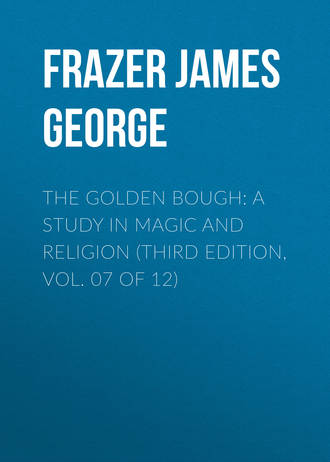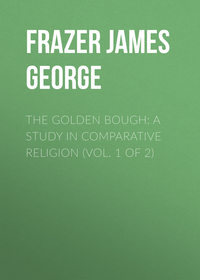 полная версия
полная версияThe Golden Bough: A Study in Magic and Religion (Third Edition, Vol. 07 of 12)
But the exact date at which the Proerosia or Festival before Ploughing took place is somewhat uncertain, and enquirers are divided in opinion as to whether it fell before or after the Great Mysteries, which began on the fifteenth or sixteenth of Boedromion, a month corresponding roughly to our September. Another name for the festival was Proarcturia, that is, “Before Arcturus,”176 which points to a date either before the middle of September, when Arcturus is a morning star, or before the end of October, when Arcturus is an evening star.177 In favour of the earlier date it may be said, first, that the morning phase of Arcturus was well known and much observed, because it marked the middle of autumn, whereas little use was made of the evening phase of Arcturus for the purpose of dating;178 and, second, that in an official Athenian inscription the Festival before Ploughing (Proerosia) is mentioned immediately before the Great Mysteries.179 On the other hand, in favour of the later date, it may be said that as the autumnal rains in Greece set in about the middle of October, the latter part of that month would be a more suitable time for a ceremony at the opening of ploughing than the middle of September, when the soil is still parched with the summer drought; and, second, that this date is confirmed by a Greek inscription of the fourth or third century b. c., found at Eleusis, in which the Festival before Ploughing is apparently mentioned in the month of Pyanepsion immediately before the festival of the Pyanepsia, which was held on the seventh day of that month.180 It is difficult to decide between these conflicting arguments, but on the whole I incline, not without hesitation, to agree with some eminent modern authorities in placing the Festival before Ploughing in Pyanepsion (October) after the Mysteries, rather than in Boedromion (September) before the Mysteries.181 However, we must bear in mind that as the Attic months, like the Greek months generally, were lunar,182 their position in the solar year necessarily varied from year to year, and though these variations were periodically corrected by intercalation, nevertheless the beginning of each Attic month sometimes diverged by several weeks from the beginning of the corresponding month to which we equate it.183 From this it follows that the Great Mysteries, which were always dated by the calendar month, must have annually shifted their place somewhat in the solar year; whereas the Festival before Ploughing, if it was indeed dated either by the morning or by the evening phase of Arcturus, must have occupied a fixed place in the solar year. Hence it appears to be not impossible that the Great Mysteries, oscillating to and fro with the inconstant moon, may sometimes have fallen before and sometimes after the Festival before Ploughing, which apparently always remained true to the constant star. At least this possibility, which seems to have been overlooked by previous enquirers, deserves to be taken into account. It is a corollary from the shifting dates of the lunar months that the official Greek calendar, in spite of its appearance of exactness, really furnished the ancient farmer with little trustworthy guidance as to the proper seasons for conducting the various operations of agriculture; and he was well advised in trusting to various natural timekeepers, such as the rising and setting of the constellations, the arrival and departure of the migratory birds, the flowering of certain plants,184 the ripening of fruits, and the setting in of the rains, rather than to the fallacious indications of the public calendar. It is by natural timekeepers, and not by calendar months, that Hesiod determines the seasons of the farmer's year in the poem which is the oldest existing treatise on husbandry.185
Offerings of the first-fruits of the barley and wheat to Demeter and Persephone at Eleusis. Isocrates on the offerings of first-fruits at Eleusis.
Just as the ploughman's prayer to Demeter, before he drove the share through the clods of the field, was taken up and reverberated, so to say, with a great volume of sound in the public prayers which the Athenian state annually offered to the goddess before the ploughing on behalf of the whole world, so the simple first-fruits of barley, presented to the rustic Demeter under the dappled shade of rustling poplars and elms on the threshing-floor in Cos, were repeated year by year on a grander scale in the first-fruits of the barley and wheat harvest, which were presented to the Corn Mother and the Corn Maiden at Eleusis, not merely by every husbandman in Attica, but by all the allies and subjects of Athens far and near, and even by many free Greek communities beyond the sea. The reason why year by year these offerings of grain poured from far countries into the public granaries at Eleusis, was the widespread belief that the gift of corn had been first bestowed by Demeter on the Athenians and afterwards disseminated by them among all mankind through the agency of Triptolemus, who travelled over the world in his dragon-drawn car teaching all peoples to plough the earth and to sow the seed.186 In the fifth century before our era the legend was celebrated by Sophocles in a play called Triptolemus, in which he represented Demeter instructing the hero to carry the seed of the fruits which she had bestowed on men to all the coasts of Southern Italy,187 from which we may infer that the cities of Magna Graecia were among the number of those that sent the thank-offering of barley and wheat every year to Athens. Again, in the fourth century before our era Xenophon represents Callias, the braggart Eleusinian Torchbearer, addressing the Lacedaemonians in a set speech, in which he declared that “Our ancestor Triptolemus is said to have bestowed the seed of Demeter's corn on the Peloponese before any other land. How then,” he asked with pathetic earnestness, “can it be right that you should come to ravage the corn of the men from whom you received the seed?”188 Again, writing in the fourth century before our era Isocrates relates with a swell of patriotic pride how, in her search for her lost daughter Persephone, the goddess Demeter came to Attica and gave to the ancestors of the Athenians the two greatest of all gifts, the gift of the corn and the gift of the mysteries, of which the one reclaimed men from the life of beasts and the other held out hopes to them of a blissful eternity beyond the grave. The antiquity of the tradition, the orator proceeds to say, was no reason for rejecting it, but quite the contrary it furnished a strong argument in its favour, for what many affirmed and all had heard might be accepted as trustworthy. “And moreover,” he adds, “we are not driven to rest our case merely on the venerable age of the tradition; we can appeal to stronger evidence in its support. For most of the cities send us every year the first-fruits of the corn as a memorial of that ancient benefit, and when any of them have failed to do so the Pythian priestess has commanded them to send the due portions of the fruits and to act towards our city according to ancestral custom. Can anything be supported by stronger evidence than by the oracle of god, the assent of many Greeks, and the harmony of ancient legend with the deeds of to-day?”189
Athenian decree concerning the offerings of first-fruits at Eleusis.
This testimony of Isocrates to the antiquity both of the legend and of the custom might perhaps have been set aside, or at least disparaged, as the empty bombast of a wordy rhetorician, if it had not happened by good chance to be amply confirmed by an official decree of the Athenian people passed in the century before Isocrates wrote. The decree was found inscribed on a stone at Eleusis and is dated by scholars in the latter half of the fifth century before our era, sometime between 446 and 420 b. c.190 It deals with the first-fruits of barley and wheat which were offered to the Two Goddesses, that is, to Demeter and Persephone, not only by the Athenians and their allies but by the Greeks in general. It prescribes the exact amount of barley and wheat which was to be offered by the Athenians and their allies, and it directs the highest officials at Eleusis, namely the Hierophant and the Torchbearer, to exhort the other Greeks at the mysteries to offer likewise of the first-fruits of the corn. The authority alleged in the decree for requiring or inviting offerings of first-fruits alike from Athenians and from foreigners is ancestral custom and the bidding of the Delphic oracle. The Senate is further enjoined to send commissioners, so far as it could be done, to all Greek cities whatsoever, exhorting, though not commanding, them to send the first-fruits in compliance with ancestral custom and the bidding of the Delphic oracle, and the state officials are directed to receive the offerings from such states in the same manner as the offerings of the Athenians and their allies. Instructions are also given for the building of three subterranean granaries at Eleusis, where the contributions of grain from Attica were to be stored. The best of the corn was to be offered in sacrifice as the Eumolpids might direct: oxen were to be bought and sacrificed, with gilt horns, not only to the two Goddesses but also to the God (Pluto), Triptolemus, Eubulus, and Athena; and the remainder of the grain was to be sold and with the produce votive offerings were to be dedicated with inscriptions setting forth that they had been dedicated from the offerings of first-fruits, and recording the names of all the Greeks who sent the offerings to Eleusis. The decree ends with a prayer that all who comply with these injunctions or exhortations and render their dues to the city of Athens and to the Two Goddesses, may enjoy prosperity together with good and abundant crops. Writing in the second century of our era, under the Roman empire, the rhetorician Aristides records the custom which the Greeks observed of sending year by year the first-fruits of the harvest to Athens in gratitude for the corn, but he speaks of the practice as a thing of the past.191
Even after foreign states ceased to send first-fruits of the corn to Eleusis, they continued to acknowledge the benefit which the Athenians had conferred on mankind by diffusing among them Demeter's gift of the corn. Testimony of the Sicilian historian Diodorus. Testimony of Cicero and Himerius.
We may suspect that the tribute of corn ceased to flow from far countries to Athens, when, with her falling fortunes and decaying empire, her proud galleys had ceased to carry the terror of the Athenian arms into distant seas. But if the homage was no longer paid in the substantial shape of cargoes of grain, it continued down to the latest days of paganism to be paid in the cheaper form of gratitude for that inestimable benefit, which the Athenians claimed to have received from the Corn Goddess and to have liberally communicated to the rest of mankind. Even the Sicilians, who, inhabiting a fertile corn-growing island, worshipped Demeter and Persephone above all the gods and claimed to have been the first to receive the gift of the corn from the Corn Goddess,192 nevertheless freely acknowledged that the Athenians had spread, though they had not originated, the useful discovery among the nations. Thus the patriotic Sicilian historian Diodorus, while giving the precedence to his fellow-countrymen, strives to be just to the Athenian pretensions in the following passage.193 “Mythologists,” says he, “relate that Demeter, unable to find her daughter, lit torches at the craters of Etna194 and roamed over many parts of the world. Those people who received her best she rewarded by giving them in return the fruit of the wheat; and because the Athenians welcomed her most kindly of all, she bestowed the fruit of the wheat on them next after the Sicilians. Wherefore that people honoured the goddess more than any other folk by magnificent sacrifices and the mysteries at Eleusis, which for their extreme antiquity and sanctity have become famous among all men. From the Athenians many others received the boon of the corn and shared the seed with their neighbours, till they filled the whole inhabited earth with it. But as the people of Sicily, on account of the intimate relation in which they stood to Demeter and the Maiden, were the first to participate in the newly discovered corn, they appointed sacrifices and popular festivities in honour of each of the two goddesses, naming the celebrations after them and signifying the nature of the boons they had received by the dates of the festivals. For they celebrated the bringing home of the Maiden at the time when the corn was ripe, performing the sacrifice and holding the festivity with all the solemnity and zeal that might be reasonably expected of men who desired to testify their gratitude for so signal a gift bestowed on them before all the rest of mankind. But the sacrifice to Demeter they assigned to the time when the sowing of the corn begins; and for ten days they hold a popular festivity which bears the name of the goddess, and is remarkable as well for the magnificence of its pomp as for the costumes then worn in imitation of the olden time. During these days it is customary for people to rail at each other in foul language, because when Demeter was mourning for the rape of the Maiden she laughed at a ribald jest.”195 Thus despite his natural prepossession in favour of his native land, Diodorus bears testimony both to the special blessing bestowed on the Athenians by the Corn Goddess, and to the generosity with which they had imparted the blessing to others, until it gradually spread to the ends of the earth. Again, Cicero, addressing a Roman audience, enumerates among the benefits which Athens was believed to have conferred on the world, the gift of the corn and its origin in Attic soil; and the cursory manner in which he alludes to it seems to prove that the tradition was familiar to his hearers.196 Four centuries later the rhetorician Himerius speaks of Demeter's gift of the corn and the mysteries to the Athenians as the source of the first and greatest service rendered by their city to mankind;197 so ancient, widespread, and persistent was the legend which ascribed the origin of the corn to the goddess Demeter and associated it with the institution of the Eleusinian mysteries. No wonder that the Delphic oracle called Athens “the Metropolis of the Corn.”198
The Sicilians seem to have associated Demeter with the seed-corn and Persephone with the ripe ears. Difficulty of distinguishing between Demeter and Persephone as personifications of different aspects of the corn.
From the passage of Diodorus which I have quoted we learn that the Sicilians celebrated the festival of Demeter at the beginning of sowing, and the festival of Persephone at harvest. This proves that they associated, if they did not identify, the Mother Goddess with the seed-corn and the Daughter Goddess with the ripe ears. Could any association or identification be more easy and obvious to people who personified the processes of nature under the form of anthropomorphic deities? As the seed brings forth the ripe ear, so the Corn Mother Demeter gave birth to the Corn Daughter Persephone. It is true that difficulties arise when we attempt to analyse this seemingly simple conception. How, for example, are we to divide exactly the two persons of the divinity? At what precise moment does the seed cease to be the Corn Mother and begins to burgeon out into the Corn Daughter? And how far can we identify the material substance of the barley and wheat with the divine bodies of the Two Goddesses? Questions of this sort probably gave little concern to the sturdy swains who ploughed, sowed, and reaped the fat fields of Sicily. We cannot imagine that their night's rest was disturbed by uneasy meditations on these knotty problems. It would hardly be strange if the muzzy mind of the Sicilian bumpkin, who looked with blind devotion to the Two Goddesses for his daily bread, totally failed to distinguish Demeter from the seed and Persephone from the ripe sheaves, and if he accepted implicitly the doctrine of the real presence of the divinities in the corn without discriminating too curiously between the material and the spiritual properties of the barley or the wheat. And if he had been closely questioned by a rigid logician as to the exact distinction to be drawn between the two persons of the godhead who together represented for him the annual vicissitudes of the cereals, Hodge might have scratched his head and confessed that it puzzled him to say where precisely the one goddess ended and the other began, or why the seed buried in the ground should figure at one time as the dead daughter Persephone descending into the nether world, and at another as the living Mother Demeter about to give birth to next year's crop. Theological subtleties like these have posed longer heads than are commonly to be found on bucolic shoulders.
The time of the year when the first-fruits of the corn were offered to Demeter and Persephone at Eleusis is not known.
The time of year at which the first-fruits were offered to Demeter and Persephone at Eleusis is not explicitly mentioned by ancient authorities, and accordingly no inference can be drawn from the date of the offering as to its religious significance. It is true that at the Eleusinian mysteries the Hierophant and Torchbearer publicly exhorted the Greeks in general, as distinguished from the Athenians and their allies, to offer the first-fruits in accordance with ancestral custom and the bidding of the Delphic oracle.199 But there is nothing to shew that the offerings were made immediately after the exhortation. Nor does any ancient authority support the view of a modern scholar that the offering of the first-fruits, or a portion of them, took place at the Festival before Ploughing (Proerosia),200 though that festival would no doubt be an eminently appropriate occasion for propitiating with such offerings the goddess on whose bounty the next year's crop was believed to depend.
The Festival of the Threshing-floor (Haloa) at Eleusis.
On the other hand, we are positively told that the first-fruits were carried to Eleusis to be used at the Festival of the Threshing-floor (Haloa).201 But the statement, cursorily reported by writers of no very high authority, cannot be implicitly relied upon; and even if it could, we should hardly be justified in inferring from it that all the first-fruits of the corn were offered to Demeter and Persephone at this festival. Be that as it may, the Festival of the Threshing-floor was intimately connected with the worship both of Demeter and of Dionysus, and accordingly it deserves our attention. It is said to have been sacred to both these deities;202 and while the name seems to connect it rather with the Corn Goddess than with the Wine God, we are yet informed that it was held by the Athenians on the occasion of the pruning of the vines and the tasting of the stored-up wine.203 The festival is frequently mentioned in Eleusinian inscriptions, from some of which we gather that it included sacrifices to the two goddesses and a so-called Ancestral Contest, as to the nature of which we have no information.204 We may suppose that the festival or some part of it was celebrated on the Sacred Threshing-floor of Triptolemus at Eleusis;205 for as Triptolemus was the hero who is said to have diffused the knowledge of the corn all over the world, nothing could be more natural than that the Festival of the Threshing-floor should be held on the sacred threshing-floor which bore his name. As for Demeter, we have already seen how intimate was her association with the threshing-floor and the operation of threshing; according to Homer, she is the yellow goddess who parts the yellow grain from the white chaff at the threshing, and in Cos her image with the corn-stalks and the poppies in her hands stood on the threshing-floor.206 The festival lasted one day, and no victims might be sacrificed at it;207 but special use was made, as we have seen, of the first-fruits of the corn. With regard to the dating of the festival we are informed that it fell in the month Poseideon, which corresponds roughly to our December, and as the date rests on the high authority of the ancient Athenian antiquary Philochorus,208 and is, moreover, indirectly confirmed by inscriptional evidence,209 we are bound to accept it. But it is certainly surprising to find a Festival of the Threshing-floor held so late in the year, long after the threshing, which in Greece usually takes place not later than midsummer, though on high ground in Crete it is sometimes prolonged till near the end of August.210 We seem bound to conclude that the Festival of the Threshing-floor was quite distinct from the actual threshing of the corn.211 It is said to have included certain mystic rites performed by women alone, who feasted and quaffed wine, while they broke filthy jests on each other and exhibited cakes baked in the form of the male and female organs of generation.212 If the latter particulars are correctly reported we may suppose that these indecencies, like certain obscenities which seem to have formed part of the Great Mysteries at Eleusis,213 were no mere wanton outbursts of licentious passion, but were deliberately practised as rites calculated to promote the fertility of the ground by means of homoeopathic or imitative magic. A like association of what we might call indecency with rites intended to promote the growth of the crops meets us in the Thesmophoria, a festival of Demeter celebrated by women alone, at which the character of the goddess as a source of fertility comes out clearly in the custom of mixing the remains of the sacrificial pigs with the seed-corn in order to obtain a plentiful crop. We shall return to this festival later on.214
The Green Festival and the Festival of the Cornstalks at Eleusis. Epithets of Demeter referring to the corn.
Other festivals held at Eleusis in honour of Demeter and Persephone were known as the Green Festival and the Festival of the Cornstalks.215 Of the manner of their celebration we know nothing except that they comprised sacrifices, which were offered to Demeter and Persephone. But their names suffice to connect the two festivals with the green and the standing corn. We have seen that Demeter herself bore the title of Green, and that sacrifices were offered to her under that title which plainly aimed at promoting fertility.216 Among the many epithets applied to Demeter which mark her relation to the corn may further be mentioned “Wheat-lover,”217 “She of the Corn,”218 “Sheaf-bearer,”219 “She of the Threshing-floor,”220 “She of the Winnowing-fan,”221 “Nurse of the Corn-ears,”222 “Crowned with Ears of Corn,”223 “She of the Seed,”224 “She of the Green Fruits,”225 “Heavy with Summer Fruits,”226 “Fruit-bearer,”227 “She of the Great Loaf,” and “She of the Great Barley Loaf.”228 Of these epithets it may be remarked that though all of them are quite appropriate to a Corn Goddess, some of them would scarcely be applicable to an Earth Goddess and therefore they add weight to the other arguments which turn the scale in favour of the corn as the fundamental attribute of Demeter.
Belief in ancient and modern times that the corn-crops depend on possession of an image of Demeter.
How deeply implanted in the mind of the ancient Greeks was this faith in Demeter as goddess of the corn may be judged by the circumstance that the faith actually persisted among their Christian descendants at her old sanctuary of Eleusis down to the beginning of the nineteenth century. For when the English traveller Dodwell revisited Eleusis, the inhabitants lamented to him the loss of a colossal image of Demeter, which was carried off by Clarke in 1802 and presented to the University of Cambridge, where it still remains. “In my first journey to Greece,” says Dodwell, “this protecting deity was in its full glory, situated in the centre of a threshing-floor, amongst the ruins of her temple. The villagers were impressed with a persuasion that their rich harvests were the effect of her bounty, and since her removal, their abundance, as they assured me, has disappeared.”229 Thus we see the Corn Goddess Demeter standing on the threshing-floor of Eleusis and dispensing corn to her worshippers in the nineteenth century of the Christian era, precisely as her image stood and dispensed corn to her worshippers on the threshing-floor of Cos in the days of Theocritus. And just as the people of Eleusis last century attributed the diminution of their harvests to the loss of the image of Demeter, so in antiquity the Sicilians, a corn-growing people devoted to the worship of the two Corn Goddesses, lamented that the crops of many towns had perished because the unscrupulous Roman governor Verres had impiously carried off the image of Demeter from her famous temple at Henna.230 Could we ask for a clearer proof that Demeter was indeed the goddess of the corn than this belief, held by the Greeks down to modern times, that the corn-crops depended on her presence and bounty and perished when her image was removed?








